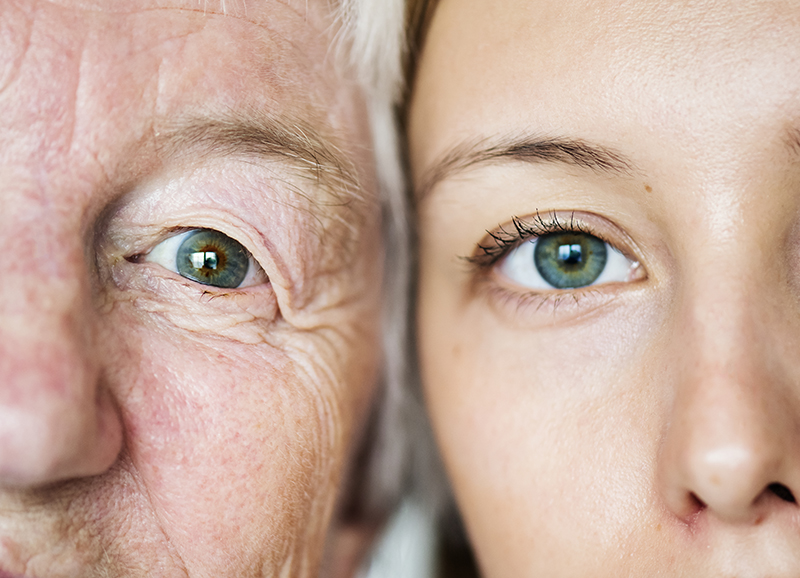Over 23 million people in the United States age 18 or older have never had an eye exam. The majority of them say it’s because they don’t have any issues with their eyes. But most eye diseases don’t show any symptoms in the early stages. Without an eye exam, there’s no way of knowing if there really is a problem.
Researchers are projecting that, by 2030:
- 11.4 million people will have diabetic retinopathy
- 4.2 million will have glaucoma
- 3.7 million will have age-related macular degeneration
Americans (that includes all you Northwest Ohioans!) ages 25 to 35 and beyond need to make sure eye health is a priority now and for the future.
That’s why we at Perrysburg Eye Center have gathered 14 interesting and important facts about maintaining healthy vision so you’ll be seeing your best for life!
1. May is Healthy Vision Month.
Protecting your vision is always important, but it’s nice to have an official month to be reminded and to learn more about why and how to care for your eyes.
This is the reason why the National Eye Institute (NEI) established May as Healthy Vision Month, encouraging Americans to make their eye health a priority and learn how to keep their eyes healthy and safe.
It’s the perfect time to learn how to protect your eyes — and help prevent vision loss in the future.
Why is Healthy Vision Month important?
Most of us know about the importance of getting physical activity and eating healthy. In fact, you probably hear about it at the water cooler or see it in your social media feeds all the time. Lots of people try diets and hit the gym because they’ve made healthy eating and living a priority.
But fewer people remember that taking care of your eyes can and should be a priority as well. Eye health is a part of overall health, after all. In fact, vision health can even help you stay safe each day.
One of the easiest ways to get started is to get a comprehensive dilated eye exam. You’ll be checked for common vision problems and eye diseases (like if you’re in the early stages), and you’ll learn if you need glasses or contacts.
And of course, we’ve got a number of other great ways to put eye vision first throughout this article and on our healthy vision blog .
Who is Healthy Vision Month for?
Healthy Vision Month is for everyone. Everyone can benefit from making eye care a priority. We’re all in this together!
But it’s also important to note that women’s eye health is unique. 2 out of 3 occurrences of blindness or visual impairments are related to women.Why do women have a different risk factor for eye diseases?
- Women live longer than men — 4 months, 4 years on average worldwide.
- They are at a greater risk for autoimmune diseases, like lupus and rheumatoid arthritis.
- Women are more likely to undergo treatments for cancer that may affect eyesight.
- Normal age-related hormonal changes may also affect women’s vision.
Ultimately everyone, no matter the age, should treat their eyes with care to protect vision for the long haul. Our eyes are the only ones we’ve got!
2. Most vision problems are preventable.
It’s true. Many people assume vision loss is unavoidable, but it actually isn’t a guarantee. Sure, there are natural, age-related processes most everyone experiences, but certain eye diseases or ailments are preventable — just by using daily tips (like the ones we’ve gathered here) to set yourself up for healthy vision that will last a lifetime.
Why don’t you encourage your friends and family to make their vision a priority? With a little education and dedication, they might be able to avoid the financial and health costs that come with neglecting vision care.
3. Sunglasses (even on cloudy days!) protect you from UV rays.
“I wear sunglasses almost all the time outside — not because I think I’m really, really cool, but because of the rays,” says Ronda Rousey, the American professional wrestler, actress, author and former mixed martial artist.
We all know sunglasses can be fashionable, able to turn nearly any outfit around. And they sure do add intrigue.
But more importantly? They can protect your eyes from ultraviolet (UV) rays.When you’re out shopping for some new shades, find a pair to wear that blocks 99%–100% of UVA/UVB rays. And to really zhoosh up the fashion, finish your look with a wide-brimmed hat for extra protection.

4. Eating eye-healthy foods protects your vision, too.
Remember when you were a kid, and adults would tell you that carrots make your eyes sparkle? Maybe you’ve even used that line on your own kids.
Well, it’s got some truth to it. Turns out, you can protect your sight by eating right.
A diet rich in fruits and veggies, specifically dark leafy greens (think spinach, collard greens and kale), goes a long way to promote healthy vision. Research also suggests that eating fish high in omega-3 fatty acids — salmon, halibut and tuna, for example — has significant eye health benefits.
You can also check out this top 10 list of foods for healthy eyes. You have to eat — might as well do it right!
5. Being overweight or obese increases your risk of conditions that affect vision.
It’s critical to maintain a healthy weight. When you’re overweight or obese, your risk of developing diabetes and other systemic conditions is greatly increased. These conditions can then cause eye conditions like diabetic eye disease or glaucoma.
Proper nutrition and healthy eating are two good ways to work towards a healthy weight. But there are many other factors that may contribute to unwanted pounds.
So if you are struggling with your weight, make sure to talk to your doctor.
6. Plenty of physical activity gives your eyes a boost.
Exercise. It can’t be recommended enough.
Back in the day (way back), our hunter-gatherer ancestors were trekking at least 5 miles daily, which included running, climbing and digging.
And, even though agriculture changed our diets, farming required our ancestors to work hard for hours on end. One way to think of it? Everyone used to be an athlete — that is, until recently.
Americans today are rarely required to do extensive physical work. Instead, we drive cars, ride elevators and push shopping carts. The result: A majority of Americans do not meet the Surgeon General’s recommendation of at least 150 minutes of exercise per week.
There are so many benefits that come with regular physical activity:
- A mood boost
- Stress reduction
- Healthy weight maintenance
But did you know that regular exercise can also protect your eyes from serious eye diseases?
It’s simple: Getting your heart to beat faster — like a quick jog before or after work — is associated with decreased risks for certain eye conditions.
Enjoying this article?
Get more like this sent to your inbox!

7. Your eyes deserve a break on the job.
You’ve been working hard. Give your peepers a rest from time to time! You earned it.
Lots of Americans today work in front of a computer . Spending lots of time focusing on a single thing, like a screen, can cause us to forget to blink enough. This makes our eyes feel fatigued and achy at the end of the workday.
Good news! There’s a quick little tip you can follow to help reduce eyestrain. It’s called the 20-20-20 rule: Every 20 minutes, look away from your screen and focus on anything about 20 feet in front of you for 20 seconds.
Your eyes will thank you.
(And if intermittently staring into space causes your coworkers to look at you strangely, you can let them in on the secret: You’re taking care of your eyeballs!)
8. Eye protection — at work and at play — makes a big difference.
Every single day, close to 2,000 Americans suffer a serious work-related eye injury.
And every 13 minutes, people with sports-related eye injuries show up at the emergency room.
One of the main reasons these eye injuries occur is that the eyes weren’t protected. Protective eyewear like safety glasses, goggles and safety shields can safeguard your eyes during games and sporting activities as well as home activities.
The law requires employers to provide a safe work environment. So if your job requires protective eyewear, make sure you’re wearing the appropriate protection at all times.
The majority of protective eyewear lenses are made of polycarbonate, which is 10x stronger than other plastics. Also, many eye care providers and some sporting goods stores sell protective eyewear.To make sure you’re wearing the right kind of protective eyewear, speak with your eye doctor.
Eye exams are not just for older folks.
While it’s true that it’s usually older men and women who have vision issues, preschoolers might not be seeing as well as they can, either.
Only 14% of preschoolers get an eye exam, and under 20% get any kind of vision screening.
According to the U.S. Preventive Services Task Force, vision screening for all kids aged 3 to 5 is recommended. This is to identify conditions like lazy eye , which can be effectively treated if it’s caught early on.

10. Your family’s eye health history can tell you a lot about your vision.
You get your eye color from your parents. It’s hereditary. But so is eye health.
That’s why you should talk to family members — parents, grandparents, aunts, uncles — about their eye health history. Since many eye diseases and conditions are hereditary , it’s helpful to learn if anyone has been diagnosed.
This vital information might help you and your doctor determine if you’re at higher risk for developing any particular eye condition or disease.
11. Quit smoking or never start.
We’re long past the days where 9 out of 10 doctors were recommending cigarette brands. It’s now understood that smoking tobacco — cigarettes, pipes and cigars — may cause serious health issues, including:
- Lung disease
- Heart disease
- Cancer
- A host of other health problems
But one often-overlooked area of health that smoking affects is eye health.
Smoking harms your eyes just as much as the rest of your body:
- Dry eye It’s when your eyes aren’t producing the right kind of tears — or not enough of them. Smoking can make your eyes feel scratchy, make them burn or sting and make them appear red.
- Cataracts A cataract is when your eye’s normally clear lens clouds up, causing blurry vision and distorted colors. They’re treated with surgery. Smoking increases your risk of cataracts.
- Age-related macular degeneration (AMD) When your macula (part of the retina) is damaged, central vision is lost, while peripheral vision stays the same. There’s no cure, though some surgery or medicine may prevent its worsening. Smokers and ex-smokers are more likely to suffer than nonsmokers.
- Diabetic retinopathy If you have diabetes and you also smoke, you’re at high risk for diabetic retinopathy, the damaging of eye blood vessels, which causes distorted vision and potentially blindness.
- Optic nerve problems Smoking increases risk factors leading to glaucoma and other optic nerve conditions.
Uveitis. The middle layer of your eye wall, the uvea, can become inflamed when you smoke, leading to pain and red eye, among other issues. - Graves’ disease This thyroid gland disease causes your eyes to bulge. Smoking can make this problem worse or even lead to vision loss.
Smoking can affect the vision of those around you, too.
If that doesn’t convince you to lay off the cigs for good, maybe this will: Smoking while pregnant makes your baby 5x more likely to get bacterial meningitis, or swelling of brain tissue, which can cause eye infections and more vision problems.
Smoking also increases your risk of premature birth — some complications may include permanent vision loss or blindness. And that’s not to mention how even second-hand smoke (smoke that has been exhaled by the smoker) can affect people around you, like your friends and family.
Making smoking a thing of the past is one of the best ways to invest in your long-term eye health.
12. Some eye conditions can cause vision loss or blindness.
As you just read, there are a number of eye diseases or conditions that can lead to significant vision loss or blindness if left untreated, including:
- Cataracts
- Diabetic retinopathy
- Glaucoma
- Age-related macular degeneration (AMD)
Some eye conditions like refractive errors — in which your eye doesn’t bend light correctly — are common and may be easily treated with glasses, contacts or laser surgery. Research estimates 11 million people in the U.S. aged 12 or older could see better with the use of corrective lenses (or surgery if applicable).
13. Washing your hands will help you avoid infection.
According to studies, 97% of females and 92% of males say they wash their hands after using the restroom. But only 75% of females and 58% of males actually do.
The stats are worse for high school and middle school students.
So it’s worth repeating here: Wash your hands! Especially before taking out your contacts. And make sure to clean your lenses properly to avoid infection.
14. Taking care of your eyes also may benefit your overall health.
If you suffer from vision problems, you’re more likely also to have any of a number of other health issues than those without vision problems, including:
- Diabetes
- Poor hearing
- Heart problems
- High blood pressure
- Lower back pain
- Strokes
- Increased risk for falls, injury and depression
A little over 54% of people aged 65 or older who are blind, and nearly 42% of the same age bracket who have impaired vision, say their overall health is fair to poor. Compare that to the 21.5% of older Americans with no vision problems who reported fair to poor health.
This just goes to show that it’s worth investing in your long-term eye health. And like we already mentioned, a comprehensive eye exam is the best way to start.Beyond eye exams, you should schedule an eye appointment with your eye doctor if you experience any of the following:
- Decreased vision
- Eye pain
- Red eye or drainage
- Double vision
- Diabetes
- Floaters (tiny specks that appear to float before your eyes)
- Circles (halos) around light sources
- Flashes of light
Conclusion
Your eyes play a big role in your overall health. And there are so many ways you can keep them healthy. Don’t forget these 14 eye health facts, and always remember to prioritize healthy vision well into your golden years!
